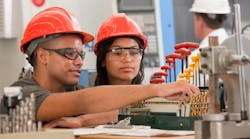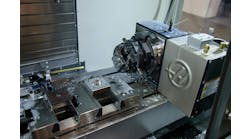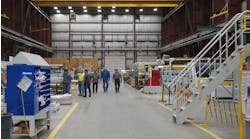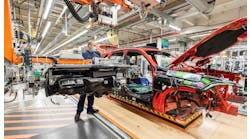SME and NASA's HUNCH Partner to Engage Youth in Advanced Manufacturing
With thousands of "baby boomers" retiring in the next decade and few new employees getting into manufacturing, manufacturers are worried about their futures. The industry is dealing with a severe shortage of workers equipped with the knowledge and skills needed to function in advanced manufacturing workplaces. Thankfully, schools are finally catching on that they are the first step to showing students the opportunities in advanced manufacturing.
SME has been working for years to bring back manufacturing education during a time when there is a big shortage of in-demand skilled talent in positions such as mechatronics, programming, welding, CNC machining, metrology and more.
To help close the skills gap, the "SME Education Foundation announced a new partnership with NASA’s agency-wide HUNCH (High School Students United with NASA to Create Hardware) program, to get more youth engaged in advanced manufacturing and ultimately encourage them to consider and pursue long-term careers in the industry." This collaboration between HUNCH and the Foundation’s Partnership Response In Manufacturing Education (PRIME) initiative will give high school students an opportunity to build actual hardware that NASA astronauts, scientists and engineers would use in their training programs and at the International Space Station (ISS).
Today, we have an estimated 600,000 jobs going unfilled because of the skills gap, but this could grow to 2 million by 2025 as "Baby Boomers" retire. This new collaboration will attract and introduce more high school students to career opportunities in the industry and prepare them to become the next generation workforce for jobs that are in high demand.
“By combining our PRIME network with NASA’s HUNCH program and working together to further expand the number of schools in the combined network, we can provide more students with access to a STEM and manufacturing focused education using hands-on learning experiences,” said Brian Glowiak, vice president of the SME Education Foundation. “Through this partnership we are motivating youth to consider careers in manufacturing and preparing them with the skill sets and knowledge to succeed.”
Through the HUNCH program, PRIME students will have the opportunity to design and build actual hardware for in-flight astronaut training or for use aboard the International Space Station, bringing real-world project based learning experiences to the classroom.
—Brian Glowiak, SME
When I interviewed Brian last week to find out more about the partnership, he said, "PRIME connects regional manufacturers with local high schools to establish or build exemplary manufacturing education programs that prepare students for skilled careers in their communities. We work with schools to provide industry-driven training for teachers as well as curriculum for the students, while giving teachers and students access to real-world manufacturing equipment and resources.
This process begins by meeting with local manufacturers to gain an understanding of the current and future skills needed by their technical workforce and then working with the administrators and educators of the local school system to help develop a robust and sustainable hands-on training program for students. This program also provides students with opportunities to acquire industry recognized credentials and to benefit from job shadowing, internship and apprenticeship experiences.”
He explained, "Through the HUNCH program, PRIME students will have the opportunity to design and build actual hardware for in-flight astronaut training or for use aboard the International Space Station, bringing real-world project based learning experiences to the classroom. Alternately, HUNCH schools will now be part of the PRIME network, having access to SME student memberships, mentoring programs, and additional technical resources."
When I asked when the SME Prime schools would start the program, he said, "We presently have 15 of our PRIME schools signed up for projects and eight have already received assignments and materials from NASA. In addition, SME is working with two HUNCH schools in Houston to start to integrate NASA's HUNCH schools into our PRIME program. Ultimately, we have an opportunity to integrate 105 schools in this collaborative program, with 41 PRIME schools and 64 HUNCH schools. Simultaneously, we are working together to expand this network by adding more schools to the combined PRIME and HUNCH program in order to recruit and prepare more students for careers in engineering and manufacturing."
He explained, "Manufacturing offers incredible and rewarding career opportunities with strong potential for advancement. Through HUNCH and PRIME we are not only building students’ awareness of these opportunities but also providing them with the skills and hands-on training needed for their future success. Moreover, giving students a chance to design and fabricate hardware for NASA and the potential opportunity to physically attach their signature to an item that could be used aboard the International Space Station is truly inspiring, both to the students and their teachers.”
I learned more about HUNCH from their website, which states that "the idea of HUNCH started when Stacy Hale, the JSC HUNCH project manager, had the innovative idea that maybe high school students could build cost-effective hardware that was needed to help train the ISS astronauts. Bob Zeek at MSFC [Marshall Space Flight Center] and Hale decided to test the feasibility of this idea. Many were skeptical about this idea, but because of the hard work and dedication of Hale and Zeek, HUNCH quickly expanded from three schools to numerous schools, in various states; the unique idea of HUNCH was quickly producing extremely positive results to all involved."
In addition, the website states, "The NASA HUNCH team at JSC [Johnson Space Center]consists of four individuals who visit schools in a four state area that produce training hardware, software, videos and flight hardware and software for NASA. The HUNCH team at Marshall Space Flight Center consists of Bob Zeek, Kriss Hougland and others that visit schools within a five state area.
Under the mentorship of HUNCH personnel last year, "the schools produced stowage lockers, cargo transfer bags, 3 minute educational videos, and experiments proposed to fly on the ISS. They have designed and fabricated a disposable, collapsible, glove box, an organizer for crew quarters on the ISS, as well as black boxes and an EPM Rack. Over the past 8 years, since the beginning of HUNCH in 2003, hundreds of items for NASA have been produced by hundreds of students."
When I interviewed Blake Ratcliff, NASA's HUNCH Program Manager, last week, he said that he has been with the program about two years at the Johnson Space Center in Houston. He said, "Stacy Hale is still a project manager, and Bob Zeek is a mentor for schools in Huntsville, Ala."
Ratcliff said, "We have gone from making training mock ups to making actual tools and other hardware items that the astronauts use at the International Space Station and when they go on space walks. The students have also made metal lockers in which the scientific payloads are put for the research the astronauts and scientists conduct on the space station."
He explained, "It is a project based program. We give schools real NASA projects that meet the needs and provide them the materials and instructions they need to complete the work. Quality is the most important aspect of the work, and the schools have done an outstanding job. Every year in April and May, we have recognition ceremonies for all the students and teachers that have participated in HUNCH at MSFC and JSC. The students present their projects during the HUNCH ceremony where some projects are selected to be used in NASA systems and on board the ISS. Every year the number of participants continues to grow as well as the quality, quantity, and diversity of the products that students fabricate."
When I asked if every school has a project, he said, "There is a wide range of build-to-print, design and prototype projects, but they also have software, communications, and culinary projects. We have a competition every year where students can come up with a new food for the astronauts. This year it is for a new dessert. The winner's food gets flown up to the space station."
I told him that I am surprised I had not heard about their program previously because I keep up with news about STEM education programs to attract the next generation of manufacturing workers. He said, "While we get a fair amount of press, it is mostly in local news outlets for the cities where our HUNCH schools are located."
He added, "There are a couple of people working to do a documentary on HUNCH. We are growing so fast that we don't need a lot of attention. It is good to publicize what we are doing, but we have been growing by word of mouth and don't need to advertise for growth. It's going to take a couple of years to integrate all of the PRIME schools into our program, so we won't be actively seeking new schools for awhile."
I asked if they have any schools in California. He said, "We just started in the Bay area and are about to sign up several schools. I asked how a school could get involved, and he said. "Go to the website and apply for a project. Then, one of our mentors will visit the school and determine if it would be a good fit and if they have the facilities to complete a project."
Both the SME PRIME initiative and NASA's HUNCH program are promoting student interest in STEM (Science, Technology, Engineering, and Mathematics.) Another benefit is that while students are building hardware and doing other projects for NASA, they are also building their interest as engineers, researchers, scientists and maybe even astronauts, as well as their self-esteem. HUNCH is a win-win innovative solution for inspiring the next generation of researchers, scientists, engineers, and manufacturing workers while providing cost-effective hardware for NASA.




